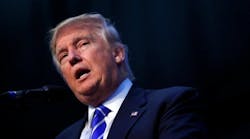The Trump administration’s first long-range defense spending plan covering fiscal years 2018-22 is a “critical opportunity” to signal U.S. strength and resolve as well as reassure wary allies, members of three leading Washington think tanks told the Senate Armed Services Committee (SASC) on Jan. 24.
President Donald Trump was elected on a platform that included rebuilding the U.S. military and repealing arbitrary spending limits enforced by the Budget Control Act of 2011, and many defense analysts in Washington and members of Congress are anticipating a ramp-up in military spending as part of Trump’s forthcoming fiscal 2018 budget request for more troops and equipment.
Trump’s national security pledges include 1,200 total combat-ready fighter aircraft for the U.S. Air Force and 350 surface ships for the U.S. Navy, plus a “state-of-the-art” missile system to thwart attacks by Iran and North Korea. He also wants to raise the U.S. Army’s active end strength to 540,000 personnel and grow the U.S. Marine Corps to 36 battalions.
Dakota Wood, senior research fellow for defense programs at the Heritage Foundation, says the next budget should “put our potential adversaries on notice” that the U.S. will operate from a position of strength while also standing by its allies.
But he cautioned against potential imbalances that could occur by shooting for specific numbers, such as enlisting too many people supported by too few jets, ships and armored vehicles, or vice versa.
“Rebuilding a force, especially one that has been depleted over so many years, must be done in a balanced way,” Wood says.
Thomas Mahnken, head of the Center for Strategic and Budgetary Assessments, says both conventional and nuclear forces need to be rebuilt instead of favoring one over the other. The U.S. has historically relied more on strategic nuclear weapons during periods of lower defense spending and spent less on those systems during conventional buildups. But after 15 years of counterinsurgency warfare in the Middle East and recent drawdowns at a time of heightened conflict in Iraq and Syria, both forces need rebuilding, Mahnken says, particularly because Russia and China have gained ground militarily.
“We are now in a period characterized by the reality of great‐power competition and the increasing possibility of great‐power conflict,” he says. “The ‘wars of the future’ may no longer lie that far in the future.”
Lawrence Korb, senior fellow at the Center for American Progress, expressed concern about spending more on the military without reform. “I don’t believe the DOD has a resource problem. I believe it has a management problem,” he told the committee.
He says the $620 billion in defense spending authorized for fiscal 2017 is about right. Korb agrees with many of the Obama administration’s actions. They include the “pivot” to the Pacific to contain China’s growing assertiveness; the European Reassurance Initiative to counter Russia and reinforce NATO allies; and the 60-nation coalition assembled to defeat the Islamic State terrorist group.
Korb supported many of the proposals contained in the Jan. 16 budget white paper of Sen. John McCain (R-Ariz.), the SASC chairman. They include revising Lockheed Martin F-35 procurement for the Air Force, Navy and Marine Corps; investing in smaller, conventionally powered, lower-cost aircraft carriers; capping the Littoral Combat Ship buy and transitioning to a more heavily armed, small surface combatant.
“I commend Trump for looking at the F-35 contract,” Korb said. “I hope it’s more than just tweets and he really gets involved in dealing with it.”
Korb backed McCain’s recommendations that the Navy should be allowed to buy fewer F-35Cs for its carrier air wings and instead extend production of the Boeing F/A-18E/F Super Hornet strike fighter and E-18G Growler electronic attack platform. McCain’s proposal for “Rebuilding American Power” recommends buying 20 additional short-takeoff-vertical-landing F-35Bs for the Marine Corps over the next five years to speed up recapitalization of the service’s legacy F/A-18 Hornets, EA-6B Prowlers and AV-8B Harriers.
At the projected rate of 48 aircraft per year, it will take the Air Force until 2040 to complete its planned purchase of 1,732 F-35As. McCain says the goal is unrealistic and requires re-evaluation, “likely a reduction.” Instead, the service should buy as many F-35As as possible “with an ultimate goal of moving beyond the program as quickly as possible.”




